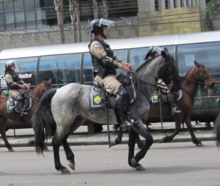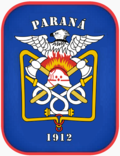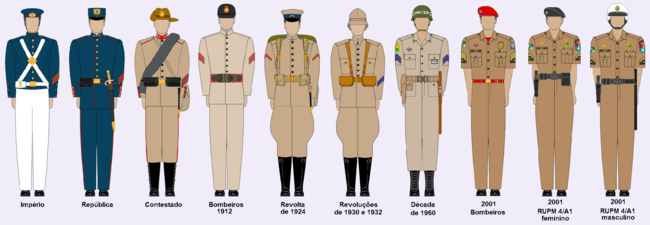Paraná Military Police
|
Paraná Military Police |
|
|---|---|
Polícia Militar do Paraná PMPR |
|
| Lineup | August 10, 1854 |
| Country | Brazil - State of Paraná
|
| Type | Gendarmerie |
| Patron saint | Joaquim Antônio de Moraes Sarmento |
| motto | Your protection is our job. Sua proteção é nosso compromisso. |
| march | Canção 10 de Agosto |
The Paraná Military Police ( Portuguese Polícia Militar do Paraná ; PMPR ) have the most important task of general patrol duty and the maintenance of public order in the state of Paraná. Their relatives are auxiliaries and reservists of the Brazilian Armed Forces and are part of the system of public security and civil defense, but not a military police in the classic sense, but a gendarmerie . Their officers are considered to be members of the state armed forces. The Paraná fire brigade corps is part of the police force.
history
The Paraná Military Police was founded on August 10, 1854 as a Tirailleure and was originally called Força Policial . This military origin stems from the need for the Brazilian Empire to reinforce its troops in an emergency. With the proclamation of the republic , Brazil adopted a constitution modeled on the USA , according to which the states have a great deal of autonomy. As a result, the police forces became a kind of regional armed forces that took part in the Triple Alliance War , among other things .
From 1946 the military police acquired their current organization, a kind of gendarmerie which is subordinate to the federal states .
Historical names

- 1854 - Força Policial .
- 1874 - Corpo de Policia .
- 1891 - Corpo Militar de Polícia .
- 1892 - Regimento de Segurança .
- 1917 - Força Militar .
- 1932 - Força Pública .
- 1939 - Força Policial .
- 1946 - Polícia Militar .
organization

The organization of the PMPR is at the operational level in battalions , companies and platoons . The battalions are in the larger urban centers; the companies and platoons are settled in accordance with the population density in the surrounding cities and towns.
The Paraná Military Police are present in every city in the state .
Battalions and Independent Military Police Company
|
Battalion 1 - Ponta Grossa ; |
Battalion 15 - Rolândia ; |
|
Company 1 - Lapa; |
Company 5 - Umuarama; |
Specialized units
- Police horse (a regiment );
- Traffic police (one battalion);
- Autobahn Police (one battalion);
- Forest police (one battalion);
- School Patrol (one battalion);
- Events (a battalion);
- Special unit (a battalion);
-
Border Guard (one battalion);
- Independent Guard Company;
Administrative departments
- Health service;
- Logistics and central procurement;
- Human resources department;
- Finance;
- Training department.
Fire brigade corps
The Paraná Fire Brigade was established in 1912. The associations are militarized and modeled on the French Sapeurs Pompiers. The fire brigade corps is integrated into the structure of the military police. A grupamento corresponds to a battalion and a subgroupamento to a company . The grupamentos and subgrupamentos are located in the larger metropolitan areas. In smaller towns and communities, fire fighting is carried out by a volunteer fire brigade .
- Grupamento 1 - Curitiba;
- Group 2 - Ponta Grossa;
- Grupamento 3 - Londrina;
- Grupamento 4 - Cascavel;
- Grupamento 5 - Maringá;
- Grupamento 6 - São José dos Pinhais;
- Grupamento 7 - Curitiba;
- Grupamento 7 - Curitiba;
- Grupamento 8 - Paranaguá;
- Grupamento 9 - Foz de Iguaçu;
- Independent Subgroup 1 - Ivaiporã;
- Independent Subgroup 2 - Pato Branco;
- Independent Subgroup 3 - Francisco Beltrão;
- Independent Subgroup 4 - Apucarana;
- Independent Subgroup 5 - Guarapuava;
- Independent Subgroup 6 - Umuarama.
Uniforms
Historically, the Brazilian armed forces have adopted the traditions of the Portuguese military. From its creation in 1854 until the early years of the republic, the PMPR had blue uniforms . In 1912 the color khaki was introduced, which is still used today. The fire brigade corps always had the same uniforms as the military police, but with their own badges .
Ranks
The PMPR has the same hierarchy as the military, with slightly different badges.
| Colonel | Lieutenant colonel | major | Captain | Lieutenant 1 | Lieutenant 2nd | Officer Candidates | Sub-lieutenant |
|---|---|---|---|---|---|---|---|
 |
 |
 |
 |
 |
 |
 |

|
| Sergeant 1st | Sergeant 2nd | Sergeant 3rd | corporal |
First class soldier |
|---|---|---|---|---|
 |
 |
 |
 |

|
Notes and individual references
- ↑ Article 42 of the Brazilian Constitution.
- ↑ Law 7, August 10, 1854.
- ^ Law 1.133, March 23, 1912.
- ↑ Decree 774, August 31, 1912.
- ^ Ordinance of the Ministry of the Army 340, October 4, 1971.
See also
Web links
- Paraná Military Police (in Portuguese)







